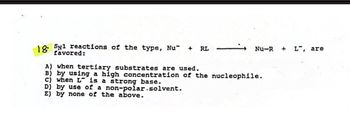
Organic Chemistry: A Guided Inquiry
2nd Edition
ISBN: 9780618974122
Author: Andrei Straumanis
Publisher: Cengage Learning
expand_more
expand_more
format_list_bulleted
Question
PROBLEM 10) Can you explain this problem and solve it correctly, please!

Transcribed Image Text:Nu-R
+
L", are
18
Syl reactions of the type, Nu¯ + RL
favored:
A) when tertiary substrates are used.
B) by using a high concentration of the nucleophile.
c) when L is a strong base.
D) by use of a non-polar-solvent.
E) by none of the above.
Expert Solution
This question has been solved!
Explore an expertly crafted, step-by-step solution for a thorough understanding of key concepts.
Step by stepSolved in 2 steps

Knowledge Booster
Similar questions
- Modify the structure to represent the organic product, if any, expected from each fo the oxidation reactions. Note that (O) represens an oxidizing agent, such as potassium dichromate, and that (O) is present in excess.arrow_forwardPlease don't provide handwritten solution .....arrow_forwarddont provide handwriting solution....arrow_forward
- Which reaction or statement regarding nucleophilic substitutions is incorrect? A) C₁ + 2 H2O ноттон + 2 HCI B) ta CI+MeOH to + HCI C) D) The rate-limiting step in SN1 reactions is the initial step, loss of the leaving group. Nucleophilic substitution reactions that follow second-order kinetics involve complete inversion of configuration.arrow_forwardLike acid chlorides, acid anhydrides react with alcohols in the presence of pyridine to form esters. For the following reaction : (a) Draw a circle around the nucleophile ; (b) Draw a square around the electrophile; (c) Put a star next to the base; (d) Draw the structure of the tetrahedral intermediate in the box below. Then draw a reasonable 3-step arrow pushing mechanism for the reaction.arrow_forwardWhat is more nucleophilic CH3O- or CH3S- ? The solvent isn't mentioned, or it can be assumed it's aprotic if needed, or in other words it doesn't interfere with nucleophilicity.arrow_forward
- Kindly answer this question iv, v & viarrow_forwardGive detailed Solution with explanation needed. don't use Ai for answering thisarrow_forwardThe question is: "Draw the curved arrow mechanism for the reaction between pentan-2-one and (CH3)3O– in t-butanol to form an enolate. Draw all electrons and charges on both resonance structures. Then answer the question about the reaction." I got the initial arrows correct, but am not entirely sure what the carbanion intermediate would look like and then what the curved arrows would be to convert it to its final oxanion formarrow_forward
- Show the arrow pushing the following. mechanismsĜ for the formation of a) Isoa camy! acetate DOctul Acetate Octy!arrow_forward2. Like acid chlorides, acid anhydrides react with alcohols in the presence of pyridine to form esters. For the following reaction: (a) Draw a circle around the nucleophile; (b) Draw a square around the electrophile; (c) Put a star next to the base; (d) Draw the structure of the tetrahedral intermediate in the box below. Then draw a reasonable 3-step arrow pushing mechanism for the reaction. pyridine + но Structure of tetrahedral intermediate Mechanism:arrow_forwardQ4. Nucleophilic attack at carbonyl with loss of carbonyl oxygen. For this question, answer AT LEAST FIVE of the SIX parts. (a) For the FOUR reactions listed below, draw structures of the major organic products. (i) (ii) (iii) HO OH ●... NMe₂NH₂ cat. dry HCI H Ph₂pⓇ THFarrow_forward
arrow_back_ios
SEE MORE QUESTIONS
arrow_forward_ios
Recommended textbooks for you
 Organic Chemistry: A Guided InquiryChemistryISBN:9780618974122Author:Andrei StraumanisPublisher:Cengage Learning
Organic Chemistry: A Guided InquiryChemistryISBN:9780618974122Author:Andrei StraumanisPublisher:Cengage Learning

Organic Chemistry: A Guided Inquiry
Chemistry
ISBN:9780618974122
Author:Andrei Straumanis
Publisher:Cengage Learning